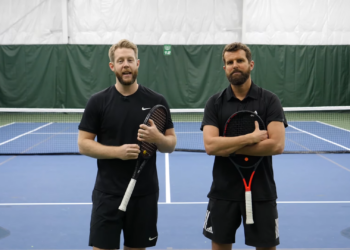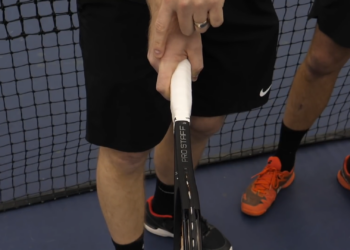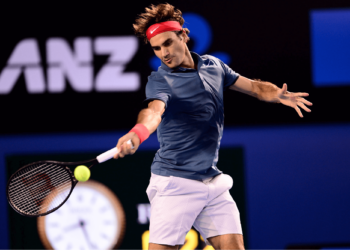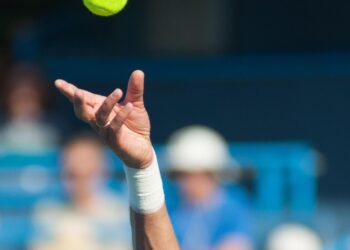Ever wondered why some players seem to blast winners effortlessly, while others seem to spin the ball into impossible angles you can’t even touch?
The secret lies in mastering your options: flat shots, topspin drives, and nasty slices that skid low and steal time from your opponents.
Each shot is a weapon and knowing when and how to unleash each one can skyrocket your game, no matter if you’re battling for league points or just out to dominate your weekend match.
We’ve seen firsthand that players who understand these shots not only improve faster, but also have a lot more fun doing it.
Ready to become the player that other people hate rallying against?
The Three Main Ways to Hit a Tennis Ball
What Is a Flat Shot in Tennis?
A flat shot is exactly what it sounds like a clean, direct hit on the ball with minimal spin.
Instead of brushing up or cutting under the ball, you drive through it, sending it on a fast, skidding trajectory that barely gives your opponent time to react. 🚀
Flat shots are ideal for first serves, attacking short balls, and putting away easy shots inside the court. Because the ball stays lower and flies faster, it’s a powerful tool when you want to finish the point quickly.
👉 Is hitting flat risky? Absolutely, but in the best possible way.
Flat shots give you huge payoff, but precision is everything. Since you’re not using topspin to pull the ball down into the court, your margin for error shrinks.
Mastering footwork, timing, and contact point is the key to making flat shots a deadly weapon instead of a liability.
What Is Topspin in Tennis?
Topspin is the magic sauce that lets you rip the ball hard and still keep it in.
When you swing with a low-to-high motion, brushing up the back of the ball, you generate topspin that makes the ball dip sharply down after it crosses the net. 🎯
Topspin shots are perfect for consistent rallies, deep groundstrokes, and attacking safely because the spin forces the ball down into the court even at high speeds.
It’s also the secret behind those nasty kicker serves that bounce over your opponent’s shoulder.
👉 Does topspin kill your power? Not at all. In fact, topspin amplifies your power safely.
You can swing faster because the ball will still drop inside the lines. That’s why you see pros like Rafa Nadal and Carlos Alcaraz swinging like wild and still landing bombs deep in the court.
PlayYourCourt teaches players early on that hitting hard without topspin is like speeding without brakes. Spin is your control system.
What Is a Slice in Tennis?
A slice shot is the polar opposite of topspin.
Instead of brushing up, you carve underneath the ball with an open racquet face, creating backspin that makes the ball float, skid, and stay low after it bounces. 🧊
Slice is your best friend on defense.
It’s what you use when you’re pulled wide, need time to recover, or want to disrupt your opponent’s rhythm with a slower, trickier ball. It’s also deadly as a drop shot when executed correctly – soft, sneaky, and impossible to reach.
👉 Is slicing too much bad? Only if you become predictable. If your opponent knows a slice is coming every time, they’ll start attacking you.
But when mixed strategically with topspin and flat shots, slice becomes a nightmare weapon that keeps your opponents guessing (and guessing wrong).
How to Hit Each Shot – Forehand, Backhand, and Serve
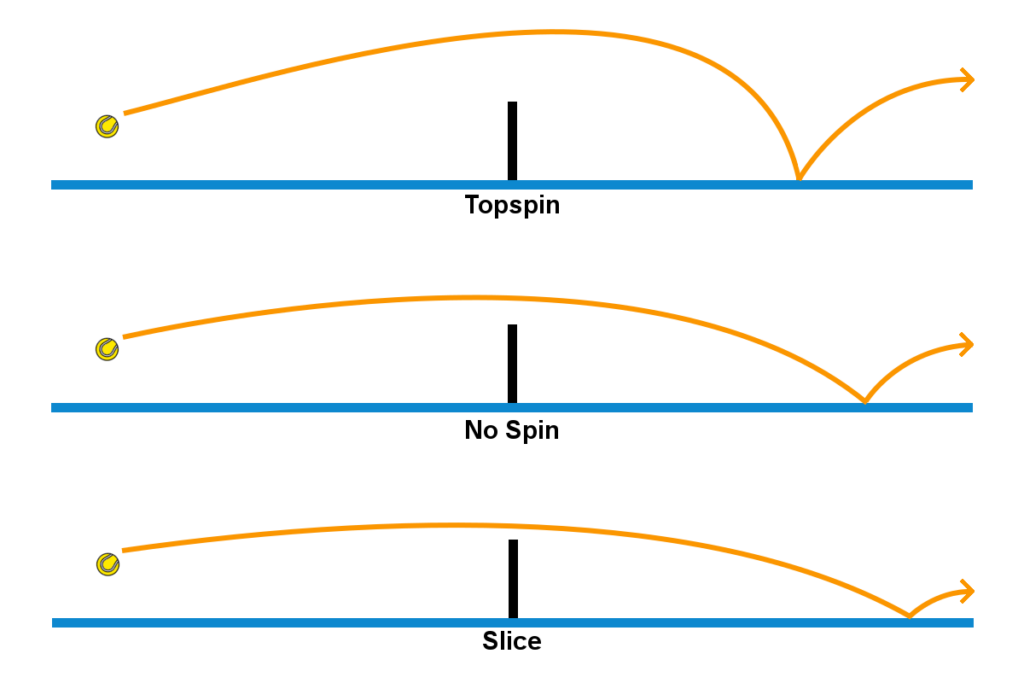
Source -> https://tennis-uni.com/en/topspin-technique/
Hitting a Flat Shot
Forehand
When you want to hammer a flat forehand, your grip choice is crucial.
Go with an Eastern or semi-western grip – both set your racquet face just right to drive through the ball without unnecessary spin.
- Feet Placement: Use a square or slightly open stance. This sets a strong foundation for linear power.
- Arm Motion: Think straight line drive – contact out in front, minimal brushing. You’re not trying to spin it, you’re trying to crush it clean.
- Body Movement: Rotate your shoulders fully, transferring your weight aggressively from your back foot to your front. It’s a full-body commitment, not just an arm swing.
Backhand
Whether you’re rocking a one-hander or a two-hander, flat backhands are about driving through the ball with crisp timing.
- Two-Handed Backhand: Use both arms to drive the racquet forward, staying compact with minimal brushing.
- One-Handed Backhand: Hold with an Eastern backhand grip, extend cleanly through the ball with a smooth follow-through.
Serve
The flat serve is your cannonball – pure power, minimal spin.
- Mechanics: Toss the ball slightly in front of you, load your legs, explode upward, and drive straight through the ball. Your wrist should stay firm – no excessive snapping like you would with a topspin or kick serve.
- Pro Tip: Use your flat serve for first serves when you want to put immediate pressure on your opponent with raw speed.
Hitting with Topspin
Forehand
To rip forehands with topspin, set your grip for spin success: go semi-western or full western if you want serious shape on your shots.
- Feet Placement: Open stance works best, it lets you rotate faster and load into that brushing motion.
- Arm Motion: Brush up the back of the ball from low to high. Your racquet should be dropping below the ball before contact and accelerating up through it.
- Body Movement: Heavy shoulder rotation plus a full follow-through that finishes high over your opposite shoulder (almost like you’re throwing a lasso!) gives you that magical combination of power and spin.
Backhand
Topspin backhands take a little more finesse but are absolute weapons when dialed in.
- Two-Handed Backhand: Brush up and across the ball. Your non-dominant hand (left for right-handers) controls most of the spin.
- One-Handed Backhand: It’s all about the extreme low-to-high swing path with stable wrist control. Think smooth and whippy.
Serve
Want your opponent to feel like the ball is bouncing into their eyeballs? That’s the kick serve.
- Kick Serve Mechanics: Toss the ball slightly behind your head, snap your wrist upward, and brush up the ball aggressively to generate massive topspin.
- Pro Tip: Kick serves are money for second serves. They give you a big margin over the net and make the returner’s life miserable.
Hitting a Slice
Forehand
Hitting a forehand slice is like skimming the ball rather than smashing it.
- Grip: Go with a continental grip (or slight eastern if you prefer a little extra bite).
- Feet Placement: A closed stance is ideal, it keeps you balanced and helps you drive through the slice smoothly.
- Arm Motion: Think about carving under the ball. Your racquet face should stay slightly open as you swing from high to low.
- Body Movement: Stay more sideways throughout the shot, rotate less than a topspin or flat shot to keep the slice tight and low.
Pro Tip: Forehand slices are great when you’re on the run or want to hit a short low ball to drag your opponent forward.
Backhand
The backhand slice is a classic, and when done right, it’s a nightmare for your opponent.
- Grip: Use a continental grip or a slight eastern backhand grip.
- Reach: Perfect for stretched, defensive situations or when you want to reset the point.
- Arm Motion: Keep a short backswing, then knife under the ball with a firm wrist. No floppy wrists here, you want that ball to stay low and skid.
- Body Movement: Keep your weight forward, stepping into the ball if you have time.
Pro Tip: The backhand slice is your best friend when you’re getting pulled wide or need to break the rhythm of a heavy topspin attacker.
Serve
The slice serve is a subtle beast, it doesn’t blast your opponent with power, it pulls them off the court and leaves them scrambling.
- Mechanics: Toss the ball slightly to the side of your hitting shoulder (right for righties, left for lefties). Carve around the outside of the ball to create sidespin.
- Arm Motion: The motion is a hybrid between a flat and a brush-around movement – think “side swipe” rather than “straight crush.”
- Body Movement: Focus on rotating your upper body through the ball so the spin carries wide and low.
Pro Tip: The slice serve is deadly out wide, especially in the deuce court if you’re right-handed. It opens the court for your next shot.
You can check out a lot of How-to content, for all of these shots, on our YouTube channel “PlayYourCourt”.
When Should You Hit Flat, Topspin, or Slice?
Choosing how you hit the ball should be your strategy.
Knowing when to go flat, spin heavy, or slice the ball can make the difference between winning easy points and getting stuck grinding out long rallies.
Let’s dive into the best times to unleash each shot.
Offensive Play (Attack)
If you’re looking to put your opponent on defense or end the point outright, here’s the game plan:
Flat
- When you get a short ball sitting up nicely – blast a flat shot!
- Whether it’s a drive or a first serve, flat shots are your finishing moves. Think “no mercy.”
Topspin
- If you’re trading groundstrokes but want to push your opponent back and take control, rip a heavy topspin forehand deep into the court.
- It’s aggressive, but safe, and sets you up for easier finishing shots.
Slice
- Slice is also a devastating tool on attack when you use it right.
- Use a forehand or backhand slice to hit a short approach shot that forces your opponent up out of their comfort zone, making them hit a low ball while you’re charging the net.
🎯 Pro Tip: A well-placed slice approach can freeze opponents who are used to heavy topspin exchanges. Keep them guessing!
Defensive Play
Sometimes, you’re the one under fire. Here’s how to survive and thrive:
Topspin
When you’re on defense, heavy topspin lobs or deep rally balls are your best friend. They give you time to recover and push your opponent back behind the baseline.
Slice
- If you’re stretched wide or have no time, float a deep slice.
- It’s like tossing a parachute up, they’ll have to generate their own pace, giving you time to reset your position.
Flat
Honestly? Flat shots are risky when scrambling.
Unless you have time to set up properly, it’s smarter to add spin. Flat shots are less forgiving when you’re off balance or under pressure.
Smart players know that defense is just offense in disguise. Stay calm, mix in spin, and look for your chance to flip the point around.
Changing the Rhythm
Tennis is chess, not checkers.
If your opponent gets into a groove, you’ve got to shake things up.
- Slice: Nothing breaks rhythm better than a nasty, low slice.Toss in a few to disrupt your opponent’s timing, force errors, or tempt them into attacking a ball that sits a little too low for their liking.
- Mixing It Up: Don’t let your opponent fall asleep. Alternate between flat drives (fast, skidding shots) and heavy topspin loops (high, heavy balls) to keep them off balance.
Make them adjust their contact point constantly, and watch the unforced errors rack up.
🎯 Pro Tip: “Change gears” during a match. Flat shots, topspin, slice, they’re all tools. Smart players don’t just hit – they choose.
Challenges You May Face (and How to Overcome Them!)
Even if you know how to hit flat, topspin, and slice shots, it’s easy to get stuck—or worse, develop bad habits that hold your game back.
Here’s how to sidestep the biggest challenges we see every day. 🎯
How to Add Topspin Without Losing Power
One of the biggest fears players have when learning topspin is:
“If I add spin, will I lose all my power?”
Short answer? Only if you do it wrong.
Topspin doesn’t steal your power, it unlocks it. The real secret to adding topspin without sacrificing speed is body rotation.
- Use your body, not just your arm: Drive with your hips and shoulders first, letting the arm follow naturally through the ball with a brushing motion.
- Generate racket head speed: The faster your racquet moves (with the right upward path), the more explosive your topspin becomes and the more control you have without swinging timidly.
We show players drills that build this kinetic chain step-by-step. Spin and speed should work together – not against each other!
How to Flatten Out Your Shots During a Rally
Sometimes, you don’t want spin, you want to flatten out and rip a clean winner. But how?
- Recognize your opportunity: Look for short balls that sit up in the court. Those are your green lights.
- Step into the court: Move forward aggressively and transfer your weight through the ball. Your contact point should be slightly higher and farther in front than with a topspin shot.
- Drive through the ball: Minimize the upward brushing motion. Keep your swing more linear, extending out towards your target.
Remember: You’re swinging smarter. Right ball, right footwork, right finish.
When Is Slicing Too Much?
Slice is awesome. But like anything else in tennis, too much of a good thing can hurt you.
- Warning sign: If your opponent starts attacking your slices easily, ripping topspin off your low balls, or moving forward to finish, it’s a red flag you’re becoming predictable.
- Solution: Mix it up. Throw in some topspin rally balls and flat drives to keep your opponent from sitting on your slice. Vary your depth, height, and spin to stay one step ahead.
🎯 Slicing smart is about variety, not just defense.
Be unpredictable, and you’ll control the rhythm – not the other way around.
The Secret to Winning More Points
At the end of the day, tennis is about making the right choice at the right time. 🧠
Realizing when to blast flat winners, when to rally with heavy topspin, and when to slice your opponent into frustration gives you a huge edge over players who only know one speed.
Every shot you hit should be a calculated weapon. Learn to read the situation, pick the right tool, and you’ll be the player that opponents dread facing. 🎾
If you’re serious about leveling up your tennis game, you don’t have to do it alone. We’ve built the ultimate resource to get you there faster and have way more fun doing it. 🎯
👉 Explore our membership today and unlock access to video coaching, custom drills, live challenges, practice partners, leagues, and everything else you need to improve your tennis game – all in one easy place.
Choose your shots wisely. Play smarter. Win more. Let’s make it happen. 🎾
